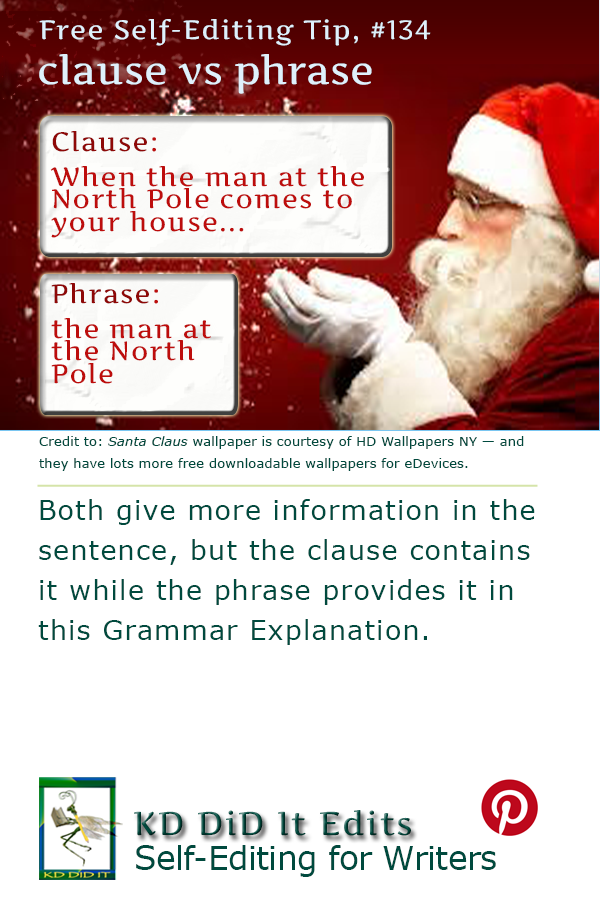While clauses and phrases might appear interchangeable, they are quite different, and it is important to understand those differences if only to know what sort of punctuation to use: commas, semicolons, or colons.
Phrase Sample:
We can meet before English, during lunch, or after school.
Clause Sample:
Later I have to clean my room, take my brother to the doctor, and take out the garbage.
Clauses
A clause is a group of related words containing a subject and a verb (a predicate) and is essentially an expanded phrase. There are two primary clauses: the independent clause and the dependent clause, a.k.a., subordinate clause.
The independent clause is a complete sentence with a subject and a predicate (a.k.a., verb) that is the entire thought or action.
The dependent clause is a group of words with a subject and a verb that is not a complete sentence (think sentence fragment) and does not convey a complete thought, although it does have different functions within a sentence. Dependent clauses can be specific to different parts of grammar:
- Adjectival Clause, a.k.a., Relative Clause
- Adverbial Clause
- Conditional Clause
- Dependent Clause
- Elliptical Clause
- Independent Clause
- Introductory Clause
- Noun Clause
- Relative Clause (a.k.a., non-restrictive /restrictive or essential/nonessential clauses or adjectival clause)
- Finite Clause can be both an independent and a dependent clause while the Non-Finite Clause is usually dependent
Phrases
A phrase is a group of related words that does not contain a subject-verb relationship, such as in the morning or running down the street or having grown used to this harassment.
You may also hear a phrase referred to as a constituent, which is simply “any word or group of words functioning as a single unit within a hierarchical structure” (Constituent).
Naturally, grammarians have run amuck categorizing phrases such as:
- Absolute Phrase
- Adjective Phrase
- Adverbial Phrase
- Appositive Phrase
- Gerund Phrase
- Infinitive Phrase
- Introductory Phrase
- Noun Phrase
- Participial Phrase
- Prepositional Phrase
- Transitional Phrase
- Verb Phrase
Grammar Explanations is . . .
. . . evolving list of the structural rules and principles that determines where words are placed in phrases or sentences as well as how the language is spoken. Sometimes I run across an example that helps explain better or another “also known as”. Heck, there’s always a better way to explain it, so if it makes quicker and/or better sense, I would appreciate suggestions and comments from anyone . . . Are there areas of grammar with which you struggle?
C’mon, get it out of your system, bitch, whine, moan . . . which words are your pet peeves? Also, please note that I try to be as accurate as I can, but mistakes happen or I miss something. Email me if you find errors, so I can fix them . . . and we’ll all benefit!
Satisfy your curiosity about other Grammar Explanations by exploring its homepage or more generally explore the index of self-editing posts. You may also want to explore Book Layout & Formatting Ideas, Formatting Tips, Grammar Explanations, Linguistics, Publishing Tips, the Properly Punctuated, Word Confusions, Writing Ideas and Resources, and Working Your Website.
Resources for Clause versus Phrase
“Constituent: Linguistics.” Wikivisually. n.d. Web. n.d. <https://wikivisually.com/wiki/Constituent_(linguistics)>.
Pinterest Photo Credits
Santa Claus wallpaper, <http://hdwallpapersny.com/santa-claus>, is courtesy of HD Wallpapers NY, which offers “easily downloadable High Definition Wallpapers for Free to your Desktop, ipad, Mac, Laptop, Tablet, Mobile Phone, and more. They have some very amazing pictures!
Revised as of 10 Dec 2022
By: Kathy Davie

